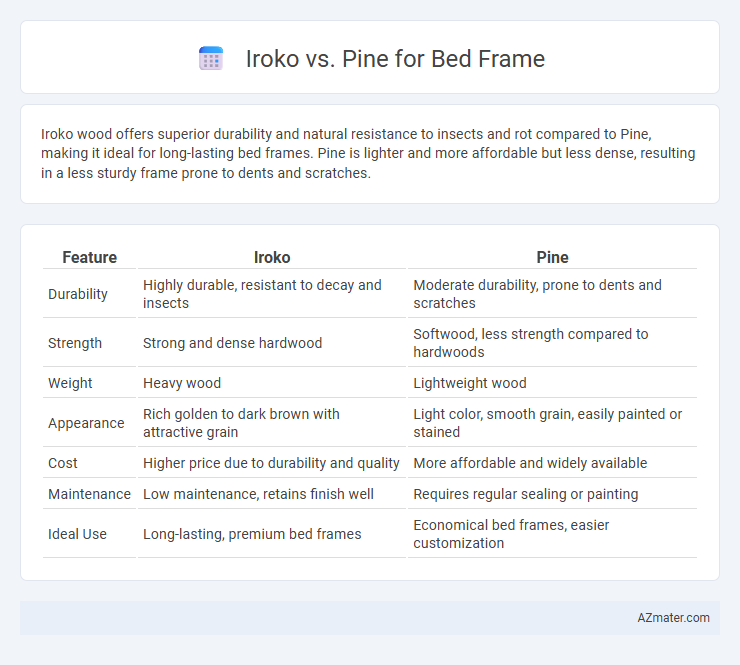Iroko wood offers superior durability and natural resistance to insects and rot compared to Pine, making it ideal for long-lasting bed frames. Pine is lighter and more affordable but less dense, resulting in a less sturdy frame prone to dents and scratches.
Table of Comparison
| Feature | Iroko | Pine |
|---|---|---|
| Durability | Highly durable, resistant to decay and insects | Moderate durability, prone to dents and scratches |
| Strength | Strong and dense hardwood | Softwood, less strength compared to hardwoods |
| Weight | Heavy wood | Lightweight wood |
| Appearance | Rich golden to dark brown with attractive grain | Light color, smooth grain, easily painted or stained |
| Cost | Higher price due to durability and quality | More affordable and widely available |
| Maintenance | Low maintenance, retains finish well | Requires regular sealing or painting |
| Ideal Use | Long-lasting, premium bed frames | Economical bed frames, easier customization |
Introduction: Iroko vs Pine for Bed Frames
Iroko wood, known for its durability and rich golden-brown hue, offers a strong and long-lasting option for bed frames compared to pine, which is lighter and more affordable but less resistant to dents and scratches. Pine's softer texture makes it easier to work with and ideal for budget-friendly furniture, while Iroko's natural oils provide enhanced resistance to moisture and pests, making it suitable for high-quality, sturdy bed frames. Choosing between Iroko and pine depends on the desired balance of durability, aesthetics, and cost for bedroom furniture.
Material Overview: Iroko Wood Characteristics
Iroko wood is a dense hardwood known for its rich golden to medium brown color, offering exceptional durability and resistance to rot and insects, making it ideal for bed frames. Its natural oils provide moisture resistance and minimal maintenance, while the coarse grain and interlocking texture create a distinctive appearance. Iroko's high strength and stability ensure long-lasting support, outperforming softer woods like pine in structural integrity.
Material Overview: Pine Wood Characteristics
Pine wood, known for its lightweight and soft texture, offers easy workability and a warm, natural aesthetic for bed frames. Its high resin content provides moderate resistance to decay and insects, making it suitable for indoor furniture, though it may dent or scratch more easily compared to hardwoods. Pine's affordability and accessibility make it a popular choice for budget-friendly, customizable bed frames with a rustic or traditional appeal.
Durability and Longevity Comparison
Iroko wood, known for its high density and natural oils, offers superior durability and resistance to rot and insect attacks, making it ideal for long-lasting bed frames. Pine, being a softer and less dense wood, is more prone to dents, scratches, and wear over time, requiring regular maintenance to ensure longevity. Overall, Iroko provides a sturdier, more durable option that can sustain heavy use and environmental stress better than pine, resulting in a longer-lasting bed frame.
Aesthetic Appeal and Color Differences
Iroko wood offers a rich, golden to medium brown hue that deepens with age, providing a warm and luxurious aesthetic ideal for sophisticated bed frame designs. Pine features a lighter, pale yellowish tone with a more rustic and casual appearance, often showcasing visible knots and grain patterns that add character. The choice between Iroko and Pine significantly impacts the bedroom ambiance, with Iroko delivering a more polished and elegant look, while Pine creates a cozy and natural vibe.
Sustainability and Environmental Impact
Iroko wood, native to West Africa, is prized for its durability and natural resistance to pests, making it a sustainable choice when sourced from responsibly managed forests with certification such as FSC. Pine, a fast-growing softwood commonly found in temperate regions, offers a lower environmental impact due to rapid regeneration rates but may require chemical treatments for pest resistance, impacting its eco-friendliness. Choosing Iroko supports tropical hardwood conservation when harvested sustainably, while pine provides a renewable option with a smaller carbon footprint if sourced from well-managed plantations.
Ease of Workability and Maintenance
Iroko wood offers moderate workability with a density around 660 kg/m3, making it easier to shape and join compared to the softer pine, which has a density near 500 kg/m3 and is highly workable for DIY projects. Maintenance of Iroko is low due to its natural resistance to decay and insect attack, requiring only occasional oiling to preserve its durability, while pine demands more frequent sealing or painting to prevent moisture damage and wear. Pine's softer texture means it is more prone to dents and scratches, increasing upkeep frequency relative to the harder and more resilient Iroko.
Cost Comparison: Iroko vs Pine
Iroko wood, known for its durability and rich golden-brown hue, typically commands a higher price per board foot compared to pine, making it a more expensive option for bed frames. Pine, a softer and more abundant wood, is significantly more affordable, often suited for budget-conscious consumers seeking lightweight and easy-to-work-with material. When comparing long-term investment, Iroko's resistance to wear and pests may offset its initial higher cost through increased longevity and reduced maintenance.
Pros and Cons of Iroko Bed Frames
Iroko bed frames offer exceptional durability and natural resistance to rot and insect damage, making them ideal for long-lasting furniture. The rich golden to dark brown hues of Iroko wood provide a luxurious aesthetic but can be more expensive and heavier compared to pine. While Iroko's hardness ensures stability, it can be challenging to work with and may require specialized tools for cutting and fastening.
Pros and Cons of Pine Bed Frames
Pine bed frames offer affordability, lightweight construction, and ease of customization, making them ideal for budget-conscious buyers and DIY enthusiasts. However, pine is softer and more prone to dents, scratches, and warping compared to harder woods like Iroko, which can compromise durability and longevity. Its natural knots and resin pockets may affect aesthetic consistency, but proper sealing and maintenance can enhance pine's resistance to wear.

Infographic: Iroko vs Pine for Bed Frame
 azmater.com
azmater.com